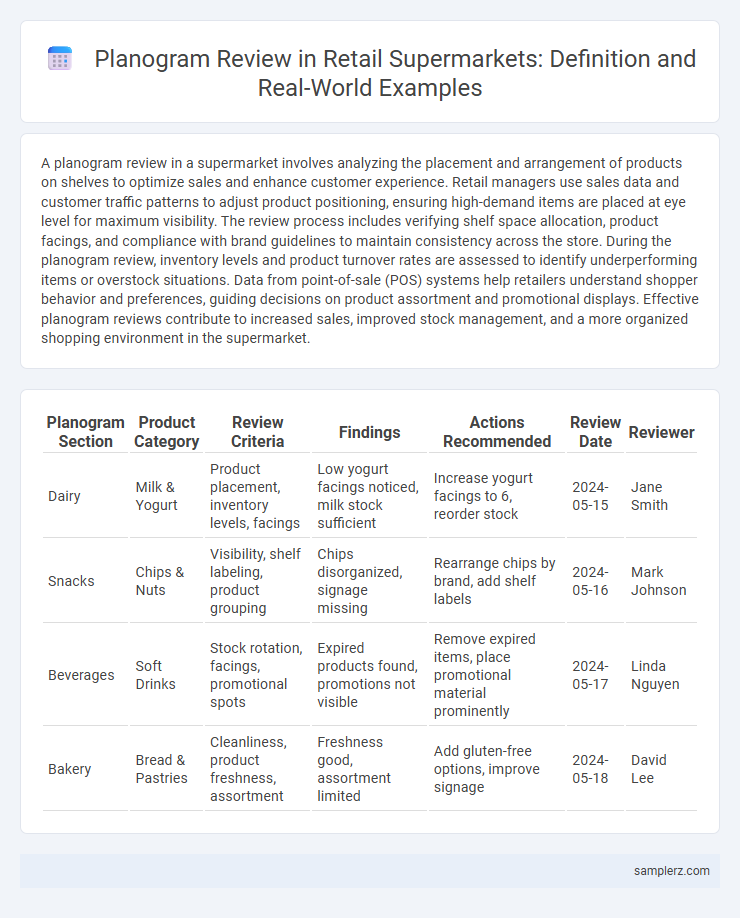A planogram review in a supermarket involves analyzing the placement and arrangement of products on shelves to optimize sales and enhance customer experience. Retail managers use sales data and customer traffic patterns to adjust product positioning, ensuring high-demand items are placed at eye level for maximum visibility. The review process includes verifying shelf space allocation, product facings, and compliance with brand guidelines to maintain consistency across the store. During the planogram review, inventory levels and product turnover rates are assessed to identify underperforming items or overstock situations. Data from point-of-sale (POS) systems help retailers understand shopper behavior and preferences, guiding decisions on product assortment and promotional displays. Effective planogram reviews contribute to increased sales, improved stock management, and a more organized shopping environment in the supermarket.
Table of Comparison
| Planogram Section | Product Category | Review Criteria | Findings | Actions Recommended | Review Date | Reviewer |
|---|---|---|---|---|---|---|
| Dairy | Milk & Yogurt | Product placement, inventory levels, facings | Low yogurt facings noticed, milk stock sufficient | Increase yogurt facings to 6, reorder stock | 2024-05-15 | Jane Smith |
| Snacks | Chips & Nuts | Visibility, shelf labeling, product grouping | Chips disorganized, signage missing | Rearrange chips by brand, add shelf labels | 2024-05-16 | Mark Johnson |
| Beverages | Soft Drinks | Stock rotation, facings, promotional spots | Expired products found, promotions not visible | Remove expired items, place promotional material prominently | 2024-05-17 | Linda Nguyen |
| Bakery | Bread & Pastries | Cleanliness, product freshness, assortment | Freshness good, assortment limited | Add gluten-free options, improve signage | 2024-05-18 | David Lee |
Understanding the Importance of Planogram Reviews in Supermarkets
Planogram reviews in supermarkets ensure optimal product placement, enhancing shopper experience and boosting sales through strategic shelf organization. Regular analysis identifies underperforming areas and adapts to consumer behavior, maximizing inventory turnover and space utilization. Effective planogram reviews support category management and promotional effectiveness, driving revenue growth and customer satisfaction.
Key Objectives of a Supermarket Planogram Review
A supermarket planogram review aims to optimize product placement to maximize sales and enhance customer experience by ensuring high-demand items are easily accessible. Key objectives include improving shelf space allocation to increase product visibility and turnover, reducing out-of-stock situations through better inventory management, and aligning displays with seasonal promotions and consumer buying behaviors. This structured approach supports data-driven decision-making to boost overall store performance and profitability.
Step-by-Step Process for Conducting a Planogram Review
Conducting a planogram review in a supermarket involves verifying product placement accuracy against the planogram schematic, ensuring shelf tags and facings align with the approved layout to optimize product visibility and sales. Auditors systematically check each category section, comparing actual stock arrangement with the predefined planogram metrics, such as facing count, shelf height, and product adjacency, to maintain merchandising consistency. Following identification of discrepancies, corrective actions are documented and communicated to store staff, facilitating adjustments that enhance shopper experience and inventory management efficiency.
Gathering Sales Data for Effective Planogram Assessment
Gathering sales data plays a crucial role in effective planogram assessment, allowing retailers to analyze product performance at the SKU level within specific supermarket aisles. By monitoring sales velocity, inventory turnover, and shelf compliance, managers can identify high-demand products and underperforming items to optimize shelf placement. Leveraging point-of-sale data and real-time analytics supports dynamic adjustments to the planogram, driving increased sales and improved customer experience.
Common Issues Detected During Planogram Reviews
Common issues detected during planogram reviews in supermarkets include incorrect product placement, resulting in reduced shelf visibility and sales. Misalignment with planogram specifications often leads to overstocking or stockouts, impacting inventory accuracy and customer satisfaction. Inconsistent facings and poor compliance with promotional displays also decrease overall planogram effectiveness and shopper engagement.
Visual Examples of Planogram Adjustments in Grocery Aisles
Planogram review in grocery aisles often involves repositioning high-demand products like cereals and snacks to eye-level shelves to boost visibility and sales. Adjustments include grouping complementary items, such as placing pasta near pasta sauce, to enhance shopper convenience and increase basket size. Visual examples show dynamic shelf spacing changes and the introduction of colorful shelf tags that guide customers toward promotions and new products.
Leveraging Planogram Software for Improved Shelf Management
Leveraging planogram software allows supermarkets to optimize shelf layouts by analyzing product placement, sales data, and customer behavior to enhance inventory visibility and boost sales. Automated planogram reviews identify underperforming product displays and recommend strategic adjustments to maximize space utilization and ensure compliance with merchandising standards. Retailers can increase shelf turnover rates and improve shopper experience by integrating real-time analytics with dynamic shelf management solutions.
Case Study: Successful Planogram Review Implementation
A successful planogram review implementation in a supermarket increased product visibility and boosted sales by 15% within three months. The case study highlighted strategic shelf space allocation and customer behavior analysis to optimize product placement. Advanced software tools enabled real-time adjustments, ensuring continuous alignment with consumer demand and inventory levels.
Measuring the Impact of Planogram Changes on Sales Performance
Analyzing sales data before and after planogram adjustments provides crucial insights into product placement effectiveness, revealing changes in purchase frequency, average transaction value, and category sales growth. Store analytics tools track shopper behavior and shelf interaction, quantifying how updated displays influence consumer engagement and impulse buys. Consistent monitoring and comparison across multiple locations validate the correlation between planogram changes and improved revenue metrics.
Best Practices for Ongoing Planogram Optimization in Retail
Regular planogram reviews in supermarkets involve analyzing sales data, customer traffic patterns, and shelf space utilization to identify underperforming products and optimize product placement. Employing technology such as planogram software and shelf-scanning devices ensures real-time adjustments and maintains compliance with merchandising standards. Continuous collaboration between category managers, store staff, and suppliers drives effective planogram optimization, improving product visibility, inventory turnover, and overall store profitability.

example of planogram review in supermarket Infographic
 samplerz.com
samplerz.com